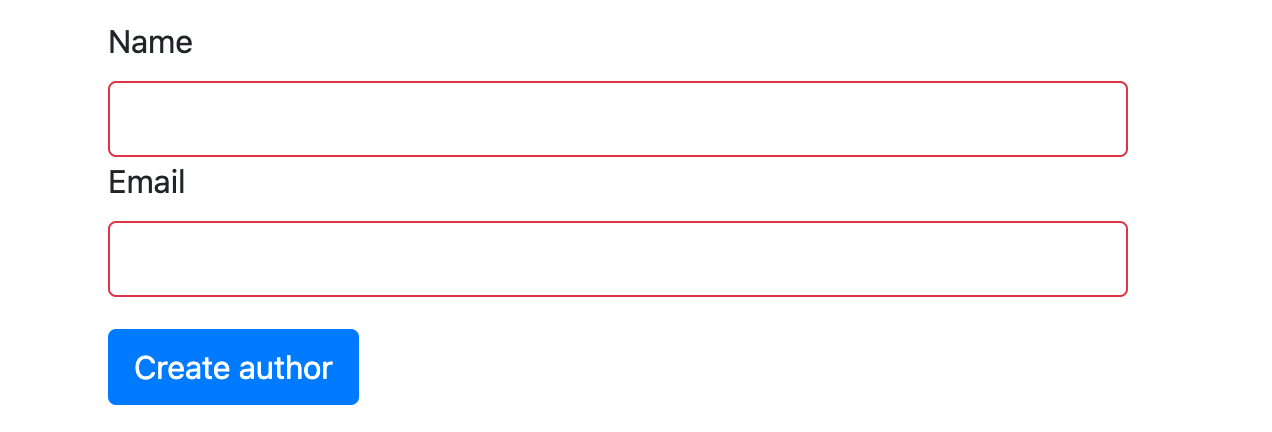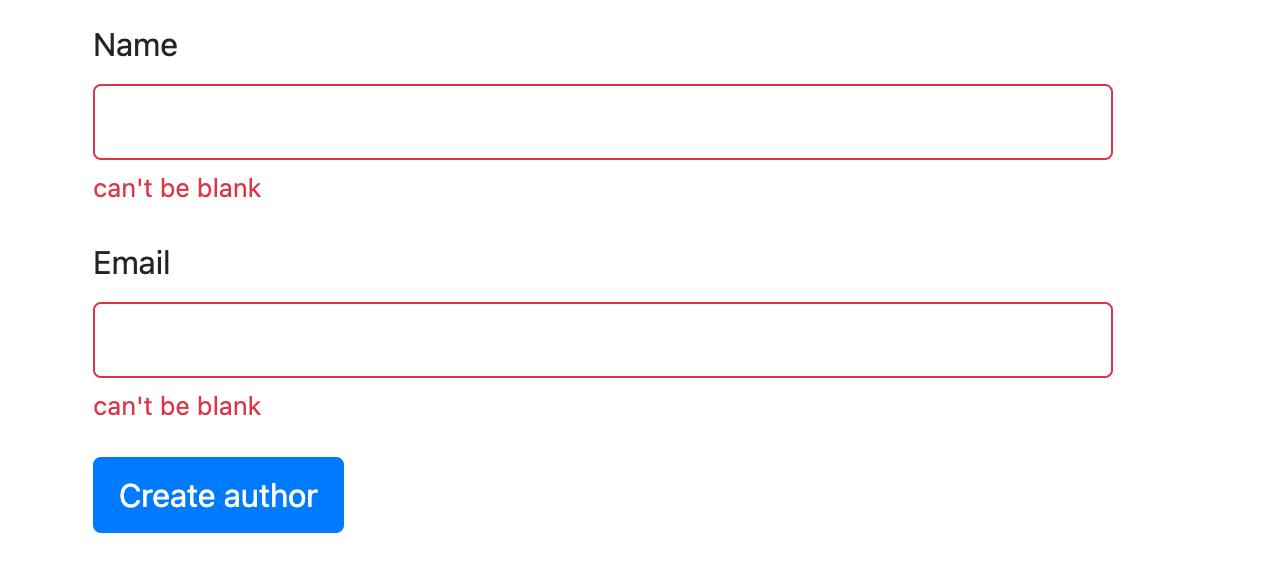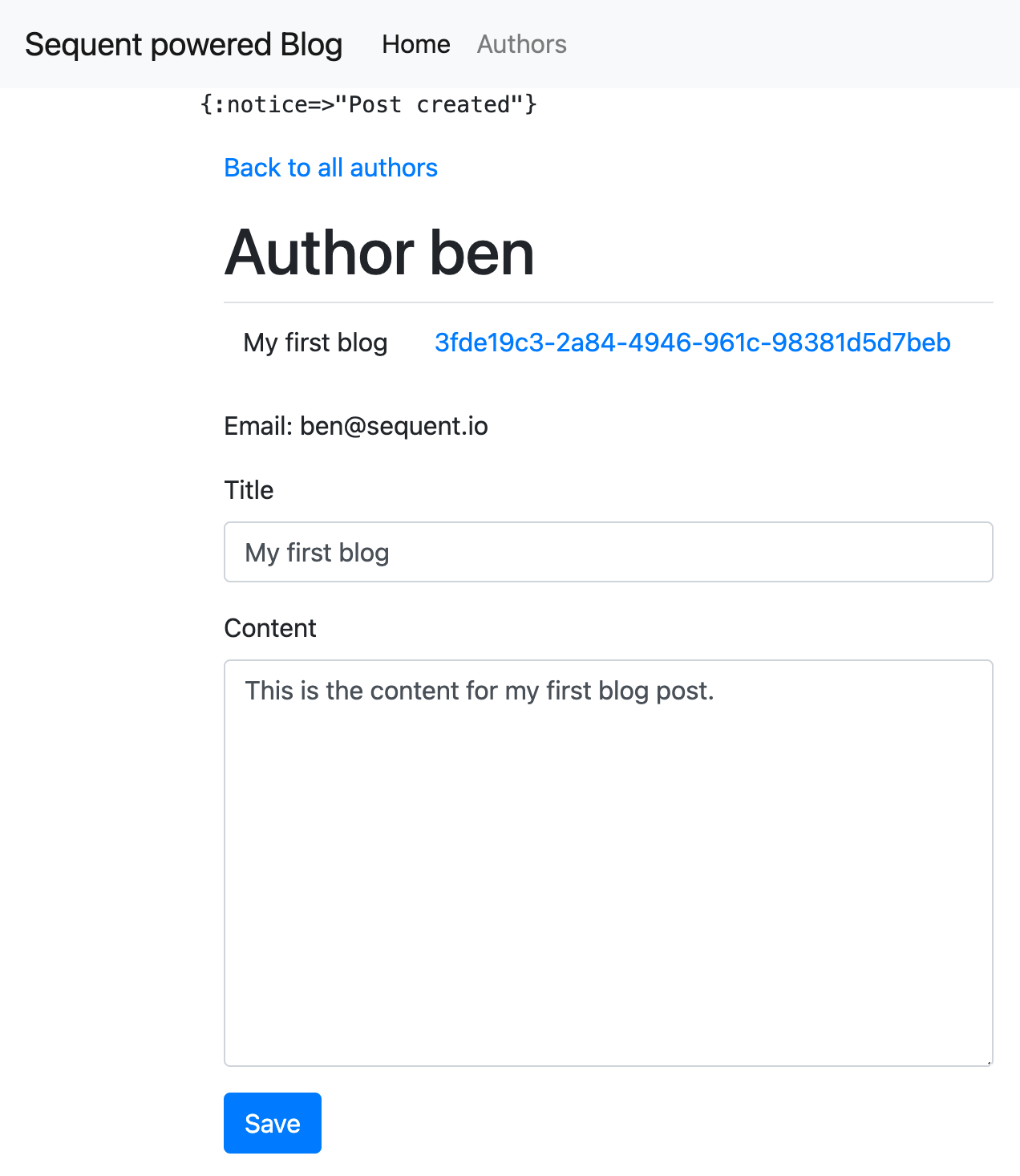Finishing the web application with Sequent
In the previous guide Building a web application we created a web application using Sequent with Sinatra. In this guide we will continue with that web application and will show you how to add Form validation, and let the Author add Posts.
Adding form validation
Every web application needs some sort of form validation. When creating a Sequent application
you typically bind a Command to a web form. A Command represents
user intent, like AddPost or AddAuthor. Sequent does not provide any view helpers to render
errors in the UI, like for instance Rails does. Sequent does however provide a way to do Command validation
using the Validation module from Rails. See validations
in our Reference Guide for all the details. For this guide we stick to the ‘create author’ form in our
web application.
In our blog application, on the home page, clicking the ‘Create author’ button without entering any values in the form, will result in the error:
Sequent::Core::CommandNotValid at /authors
Invalid command AddAuthor 57424bba-1bb3-4cfb-9d64-5b974ff5f3ff, errors: {:name=>["can't be blank"], :email=>["can't be blank"]}
Let’s take a look at the AddAuthor command:
class AddAuthor < Sequent::Command
attrs name: String, email: String
validates_presence_of :name, :email
end
Currently we only check whether the name and email attributes are present, but we could add any validates method
from the Rails ActiveModel::Validations,
since it is incorporated into Sequent.
In order to provide proper feedback to the user, we need to handle this error in Sinatra and display the error messages at the correct fields.
Layout setup
To display the error messages at the correct fields, we need to add Bootstrap for a nifty look and feel and add an erb layout file to manage all displayed erb code (which gets automatically picked up by Sinatra).
Create the file app/views/layout.erb with:
<!doctype html>
<html>
<head>
<meta name="viewport" content="width=device-width, initial-scale=1, shrink-to-fit=no">
<link rel="stylesheet" href="https://maxcdn.bootstrapcdn.com/bootstrap/4.0.0/css/bootstrap.min.css" integrity="sha384-Gn5384xqQ1aoWXA+058RXPxPg6fy4IWvTNh0E263XmFcJlSAwiGgFAW/dAiS6JXm" crossorigin="anonymous">
</head>
<body>
<nav class="navbar navbar-expand navbar-light bg-light">
<a class="navbar-brand" href="#">Sequent powered Blog</a>
<ul class="navbar-nav mr-auto">
<li class="nav-item active">
<a class="nav-link" href="/">Home</a>
</li>
<li class="nav-item">
<a class="nav-link" href="/authors">Authors</a>
</li>
</ul>
</nav>
<main role="main" class="container">
<% ([flash[:notice]].flatten.compact).each do |info| %>
<div class="alert alert-info" role="alert">
<%= h info %>
</div>
<% end %>
<%= yield %>
</main></body></html>
Display error messages
In order to display the error messages in the form we first need to rescue from the Sequent::Core::CommandNotValid
in the post '/authors' method.
We will make two changes in app/web.rb:
- Add a rescue block and store the errors in
@errors. We will use this in the erb to display the error messages. - Change the
commandattribute into an instance variable@command, to allow access from an erb file. This is necessary, since we want to be able to get and display any erroneous values (available in the command) the user has entered.
Update the post /authors action in app/web.rb with:
post '/authors' do
author_id = Sequent.new_uuid
@command = AddAuthor.from_params(params.merge(aggregate_id: author_id))
Sequent.command_service.execute_commands @command
flash[:notice] = 'Account created'
redirect "/authors/#{author_id}"
rescue Sequent::Core::CommandNotValid => e
@errors = e.errors
erb :index
end
Next, we need to change the html form and add some helper methods.
Render form fields in red when they contain an invalid value by replacing app/views/index.erb to:
<form method="post" action="/authors">
<div class="form-group">
<label for="name">Name</label>
<input
id="name"
name="name"
type="text"
value="<%= h @command&.name %>"
class="form-control <%= error_css_class(:name) %>"
/>
<div class="form-group">
<label for="email">Email</label>
<input
id="email"
name="email"
type="email"
value="<%= h @command&.email %>"
class="form-control <%= error_css_class(:email) %>"
/>
</div>
<button class="btn btn-primary">Create author</button>
</form>
Add helpers to get the errors pertaining to certain attributes, add the helpers block below helpers ERB::Util in app/web.rb:
helpers do
def has_errors_for(attribute)
@errors && @errors[attribute].present?
end
def errors(attribute)
@errors[attribute] if has_errors_for(attribute)
end
def error_css_class(attribute)
has_errors_for(attribute) ? 'is-invalid' : ''
end
end
When we now submit an empty form, we can see the input fields are displayed in red:

The last thing we need to do, is display the error messages underneath the relevant input fields.
To enable this functionality, we replace app/views/index.erb with:
<form method="post" action="/authors">
<div class="form-group">
<label for="name">Name</label>
<input
id="name"
name="name"
type="text"
value="<%= h @command&.name %>"
class="form-control <%= error_css_class(:name) %>"
/>
<% if has_errors_for(:name) %>
<div class="invalid-feedback">
<% errors(:name).each do |error| %>
<p><%= h error %></p>
<% end %>
</div>
<% end %>
<div class="form-group">
<label for="email">Email</label>
<input
id="email"
name="email"
type="email"
value="<%= h @command&.email %>"
class="form-control <%= error_css_class(:email) %>"
/>
<% if has_errors_for(:email) %>
<div class="invalid-feedback">
<% errors(:email).each do |error| %>
<p><%= h error %></p>
<% end %>
</div>
<% end %>
</div>
<button class="btn btn-primary">Create author</button>
</form>
When we now submit an empty form, the error messages are displayed underneath the relevant input fields:

So to summarize, when creating a web application:
- In Sequent you typically bind forms to
Commandobjects - You can rescue from the
Sequent::Core::CommandNotValidin order to display validation errors from the Commands - With Sinatra, it is trivial to display those errors the ‘Railsy’ way.
Handling Errors outside Command Validation
What about errors that occur outside Command validation? Remember that we enforce uniqueness of email addresses in the
Authors AggregateRoot. This will raise a Sequent::Core::AggregateKeyNotUniqueError error and is not rescued in our
web application.
Again, this is not something that Sequent handles for you, since it is not a web framework. It is however not that hard to rescue from. Since we only have one custom error class in this example we will rescue this error explicitly.
Change the post /authors action in app/web.rb to:
post '/authors' do
author_id = Sequent.new_uuid
@command = AddAuthor.from_params(params.merge(aggregate_id: author_id))
Sequent.command_service.execute_commands @command
flash[:notice] = 'Account created'
redirect "/authors/#{author_id}"
rescue Sequent::Core::CommandNotValid => e
@errors = e.errors
erb :index
rescue Sequent::Core::AggregateKeyNotUniqueError
@errors = {email: ['already registered, please choose another']}
erb :index
end
Tip: If your application grows, it is possible to create a custom base error class for your app and rescue from that in your Sinatra controllers.
Adding and editing Posts
In order to have a fully working blog application, an author needs to be able to submit and edit posts. In this example we won’t go into detail on how to handle logging in, since that is outside of Sequent scope.
For now we will just add the ability to add and edit a Post on the Author’s show page. Since this is somewhat of a
repeat of what we did earlier for creating an Author, we only show the code that needs to be added.
Domain logic for editing posts
In lib/post/commands.rb add:
class EditPost < Sequent::Command
attrs title: String, content: String
validates_presence_of :title, :content
end
In lib/post/post_command_handler.rb add:
on EditPost do |command|
do_with_aggregate(command, Post) do |post|
post.edit(command.title, command.content)
end
end
In lib/post/post.rb add:
def edit(title, content)
apply PostTitleChanged, title: title
apply PostContentChanged, content: content
end
Change the handling of PostAuthorChanged in app/projectors/post_projector.rb to:
on PostAuthorChanged do |event|
update_all_records(PostRecord, {aggregate_id: event.aggregate_id}, event.attributes.slice(:author_aggregate_id))
end
Sinatra actions
In app/web.rb add:
post '/authors/id/:author_id/post' do
post_id = Sequent.new_uuid
@command = AddPost.from_params(
params.merge(
aggregate_id: post_id,
author_aggregate_id: params[:author_id],
)
)
Sequent.command_service.execute_commands @command
flash[:notice] = 'Post created'
redirect "/authors/id/#{params[:author_id]}/post/#{post_id}"
rescue Sequent::Core::CommandNotValid => e
@author = AuthorRecord.find_by(aggregate_id: params[:author_id])
@errors = e.errors
erb :'authors/show'
end
get '/authors/id/:author_id/post/:post_id' do
@author = AuthorRecord.find_by(aggregate_id: params[:author_id])
post_record = PostRecord.find_by(aggregate_id: params[:post_id])
@command = EditPost.new(
aggregate_id: params[:post_id],
title: post_record.title,
content: post_record.content,
)
erb :'authors/show'
end
post '/authors/id/:author_id/post/:post_id' do
@command = EditPost.from_params(
params.merge(
aggregate_id: params[:post_id],
)
)
Sequent.command_service.execute_commands @command
flash[:notice] = 'Post saved'
redirect back
rescue Sequent::Core::CommandNotValid => e
@author = AuthorRecord.find_by(aggregate_id: params[:author_id])
@errors = e.errors
erb :'authors/show'
end
helpers do
def post_action(command)
@command&.is_a?(EditPost) ? "/authors/id/#{params[:author_id]}/post/#{command.aggregate_id}" : "/authors/id/#{params[:author_id]}/post"
end
end
Adding views
Let’s add a view for displaying the details of an Author, their posts, and editing/adding a new post.
The complete app/views/authors/show.erb
<div class="container">
<p>
<a href="/authors">Back to all authors</a>
</p>
<h1>Author <%= h @author.name %> </h1>
<table class="table">
<tbody>
<% @author.post_records.order(:id).each do |post_record| %>
<tr>
<td><%= h post_record.title %></td>
<td>
<a href="<%= "/authors/id/#{@author.aggregate_id}/post/#{post_record.aggregate_id}" %>">
<%= h post_record.aggregate_id %>
</a>
</td>
</tr>
<% end %>
</tbody>
</table>
<p>Email: <%= h @author.email %></p>
<form method="post" action="<%= post_action(@command) %>">
<div class="form-group">
<label for="title">Title</label>
<input
id="title"
name="title"
type="text"
value="<%= h @command&.title %>"
class="form-control <%= error_css_class(:title) %>"
/>
<% if has_errors_for(:title) %>
<div class="invalid-feedback">
<% errors(:title).each do |error| %>
<p><%= h error %></p>
<% end %>
</div>
<% end %>
</div>
<div class="form-group">
<label for="content">Content</label>
<textarea
id="content"
name="content"
rows="10"
class="form-control <%= error_css_class(:content) %>"
><%= h @command&.content %></textarea>
<% if has_errors_for(:content) %>
<div class="invalid-feedback">
<% errors(:content).each do |error| %>
<p><%= h error %></p>
<% end %>
</div>
<% end %>
</div>
<button class="btn btn-primary">Save</button>
</form>
</div>
Since we follow a naming convention in the AddPost command and EditPost command, we can use the same form.
Update database
In order to access the post records from our author record, we need to add a has_many relation to
PostRecords in AuthorRecord.
Replace app/records/author_record.rb with:
class AuthorRecord < Sequent::ApplicationRecord
has_many :post_records, foreign_key: 'author_aggregate_id', primary_key: 'aggregate_id'
end
We also need to add this new foreign_key as a new column in the post table.
Replace db/tables/post_records.sql with:
CREATE TABLE post_records%SUFFIX% (
id serial NOT NULL,
aggregate_id uuid NOT NULL,
author_aggregate_id uuid,
title character varying,
content character varying,
CONSTRAINT post_records_pkey%SUFFIX% PRIMARY KEY (id)
);
CREATE UNIQUE INDEX post_records_keys%SUFFIX% ON post_records%SUFFIX% USING btree (aggregate_id);
Finally, migrate the database, just like you did before.
Update the view schema version in db/migrations.rb and add the PostProjector to the versions method:
VIEW_SCHEMA_VERSION = 3
def self.versions
{
'1' => [
PostProjector
],
'2' => [ # Projectors that need to be rebuild:
AuthorProjector
],
'3' => [
PostProjector
]
}
end
Stop your app and run the migrations:
bundle exec rake sequent:migrate:online &&
bundle exec rake sequent:migrate:offline
I, [..] INFO -- : Start migrate_online for version 3
I, [..] INFO -- : Number of groups 4096
I, [..] INFO -- : groups: 4096
I, [..] INFO -- : Start replaying events
I, [..] INFO -- : Done migrate_online for version 3
I, [..] INFO -- : Start migrate_offline for version 3
I, [..] INFO -- : Number of groups 16
I, [..] INFO -- : groups: 16
I, [..] INFO -- : Start replaying events
I, [..] INFO -- : Migrated to version 3
Result
Now you’re able to add and edit post for an author.

Extending Domain Logic
In this guide we have added form validation and added the ability for Authors to add and edit Posts.
If your domain requires Authors to keep track of their Posts to enforce a certain business rule, you will
explicitly need to add this to your domain logic. This can be done for instance in the PostCommandHandler:
on AddPost do |command|
post = Post.new(command)
repository.add_aggregate(post)
author = repository.load_aggregate(command.author_aggregate_id, Author)
author.add_post(post.id)
end
Of course, the requirement of this functionality entirely depends on your domain.
Summary
In this guide we learned about:
- Adding the ability for
Authorsto add and editPosts - How to add form validation to views using Sequent Command Validation
- Mapping errors to views using
rescue Sequent::Core::CommandNotValid
The full source code of the web application is available in the sequent-examples repository.